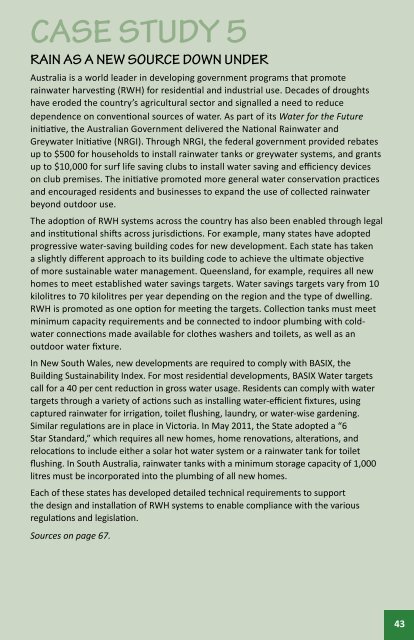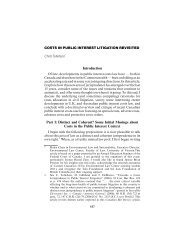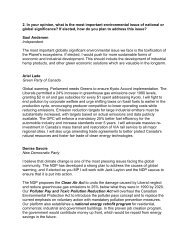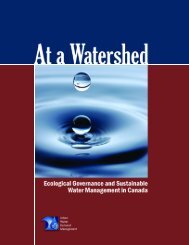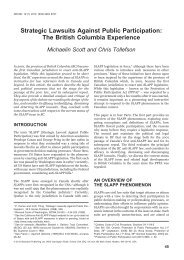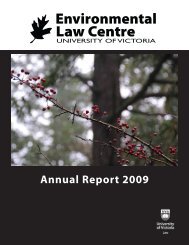Peeling back the Pavement - POLIS Water Sustainability Project
Peeling back the Pavement - POLIS Water Sustainability Project
Peeling back the Pavement - POLIS Water Sustainability Project
Create successful ePaper yourself
Turn your PDF publications into a flip-book with our unique Google optimized e-Paper software.
CASE STUDY 5<br />
RAIN AS A NEW SOURCE DOWN UNDER<br />
Australia is a world leader in developing government programs that promote<br />
rainwater harvesting (RWH) for residential and industrial use. Decades of droughts<br />
have eroded <strong>the</strong> country’s agricultural sector and signalled a need to reduce<br />
dependence on conventional sources of water. As part of its <strong>Water</strong> for <strong>the</strong> Future<br />
initiative, <strong>the</strong> Australian Government delivered <strong>the</strong> National Rainwater and<br />
Greywater Initiative (NRGI). Through NRGI, <strong>the</strong> federal government provided rebates<br />
up to $500 for households to install rainwater tanks or greywater systems, and grants<br />
up to $10,000 for surf life saving clubs to install water saving and efficiency devices<br />
on club premises. The initiative promoted more general water conservation practices<br />
and encouraged residents and businesses to expand <strong>the</strong> use of collected rainwater<br />
beyond outdoor use.<br />
The adoption of RWH systems across <strong>the</strong> country has also been enabled through legal<br />
and institutional shifts across jurisdictions. For example, many states have adopted<br />
progressive water-saving building codes for new development. Each state has taken<br />
a slightly different approach to its building code to achieve <strong>the</strong> ultimate objective<br />
of more sustainable water management. Queensland, for example, requires all new<br />
homes to meet established water savings targets. <strong>Water</strong> savings targets vary from 10<br />
kilolitres to 70 kilolitres per year depending on <strong>the</strong> region and <strong>the</strong> type of dwelling.<br />
RWH is promoted as one option for meeting <strong>the</strong> targets. Collection tanks must meet<br />
minimum capacity requirements and be connected to indoor plumbing with coldwater<br />
connections made available for clo<strong>the</strong>s washers and toilets, as well as an<br />
outdoor water fixture.<br />
In New South Wales, new developments are required to comply with BASIX, <strong>the</strong><br />
Building <strong>Sustainability</strong> Index. For most residential developments, BASIX <strong>Water</strong> targets<br />
call for a 40 per cent reduction in gross water usage. Residents can comply with water<br />
targets through a variety of actions such as installing water-efficient fixtures, using<br />
captured rainwater for irrigation, toilet flushing, laundry, or water-wise gardening.<br />
Similar regulations are in place in Victoria. In May 2011, <strong>the</strong> State adopted a “6<br />
Star Standard,” which requires all new homes, home renovations, alterations, and<br />
relocations to include ei<strong>the</strong>r a solar hot water system or a rainwater tank for toilet<br />
flushing. In South Australia, rainwater tanks with a minimum storage capacity of 1,000<br />
litres must be incorporated into <strong>the</strong> plumbing of all new homes.<br />
Each of <strong>the</strong>se states has developed detailed technical requirements to support<br />
<strong>the</strong> design and installation of RWH systems to enable compliance with <strong>the</strong> various<br />
regulations and legislation.<br />
Sources on page 67.<br />
43


